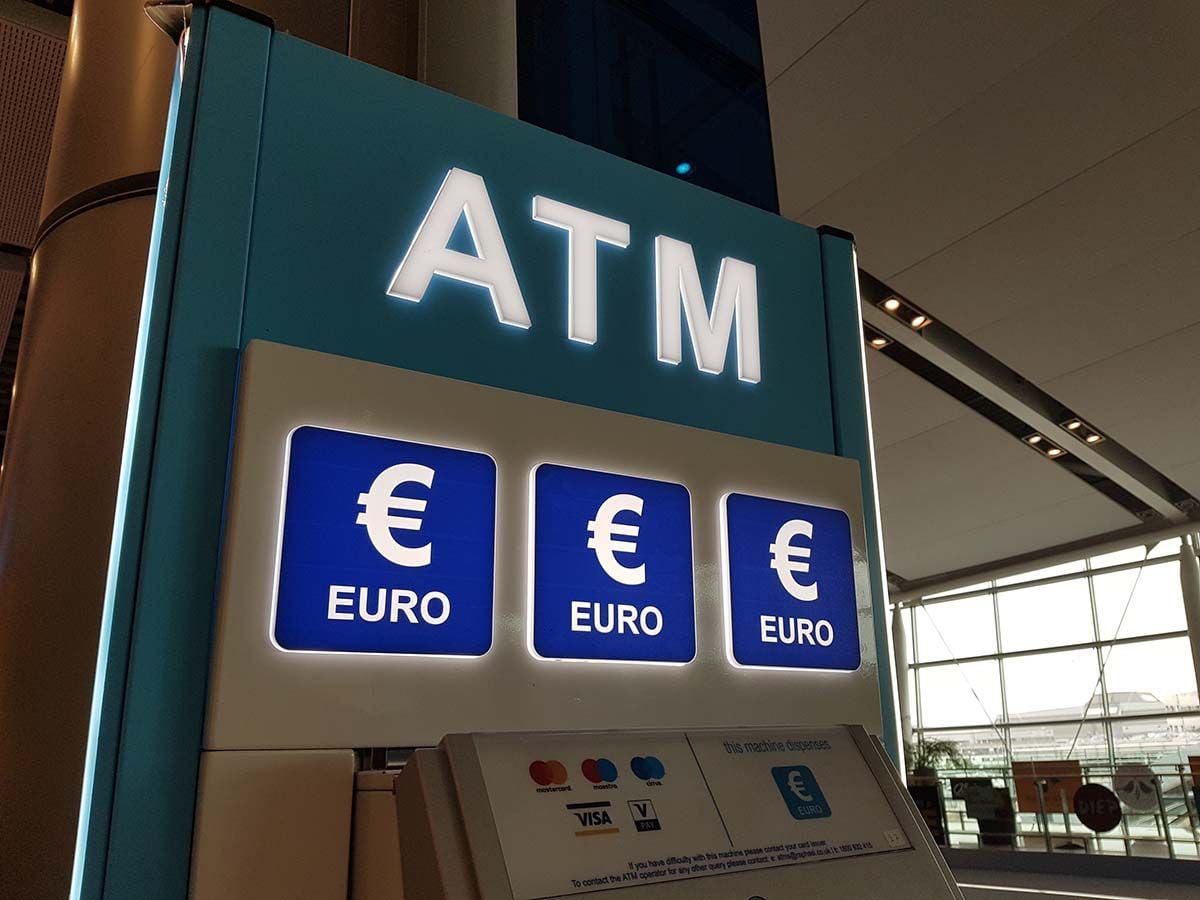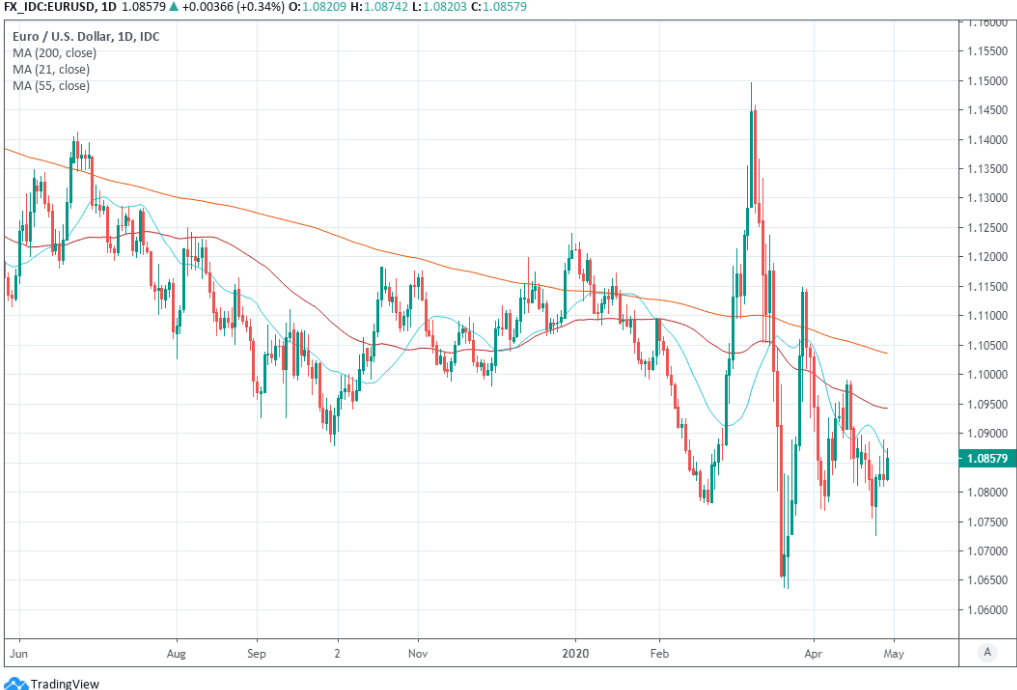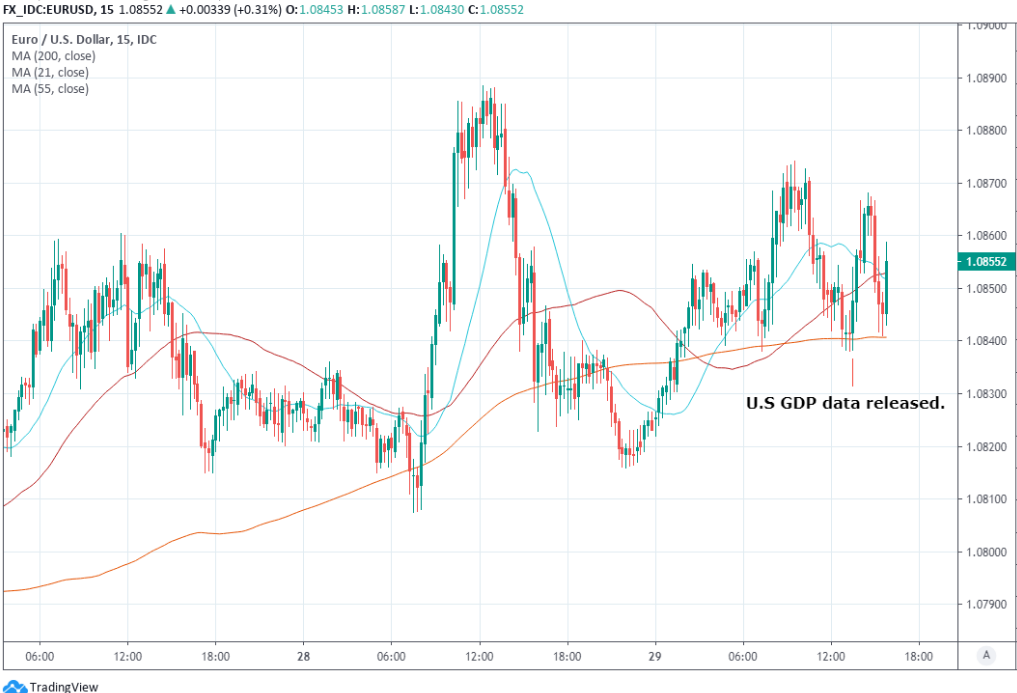Euro Rates Subject to GDP Data, ECB Decision Today
- Written by: James Skinner
- Editorial View;
- EUR/USD advances after U.S. GDP data, ahead of Fed.
- But iceberg ahead in Thursday's Eurozone GDP figures.
- Markets understimated U.S. virus hit, likely do with EZ too.
- EUR wound would be worse if ECB steps aside Thursday.

© Pound Sterling Live
- EUR/USD spot at time of writing: 1.0847
- Bank transfer rates (indicative): 1.0469-1.0545
- FX specialist rates (indicative): 1.0686-1.0751 >> More information
The Euro-to-Dollar exchange rate has rallied into month-end following a larger-than-expected fall in U.S. first-quarter GDP growth, but faces its own challenges on Thursday as Eurozone GDP is due for release and the European Central Bank (ECB) will update markets with its latest policy decisions.
Europe's single currency was holding its own already ahead of Wednesday's U.S. GDP figures but began climbing after the Bureau of Economic Analysis said the world's largest economy shrank by -4.8% last quarter, a far larger fall than the -4% anticipated by the consensus.
The Euro-to-Dollar rate climbed from 1.0838 in response to the figures, which were released alongside a notification from Gilead Sciences that its remdisivir antiviral drug remdesivir had met its primary endpoint in clinical trials designed to gauge its efficacy as a treatment for coronavirus.
Gilead did however caution that remdesivir "has not yet been demonstrated to be safe or effective for the treatment of COVID-19".
Above: Euro-to-Dollar rate shown at 15-minute intervals.
Eurozone first-quarter GDP will be released at 10:00 with individual countries reporting before and after, while the consensus supposedly favours a -3.7% contraction that would be the largest decline since early 2009.
That's a lesser hit than was seen as well as expected in the U.S., but for an economy that was weaker to begin with, quicker to contract the coronavirus and which has spent longer under the draconian kinds of 'lockdown' inspired by China's response to the pneumonia-inducing disease.
There's only one coronavirus-plagued European economy that consensus expects to do worse than the U.S. Thursday and that's Italy, but only narrowly so given expectations for a -5% decline when the Italian National Institute of Statistics releases its number at 11:00.
Italy, Spain, Germany and France all came to a standstill well before the streets of New York became desolate.
This is a Eurozone that was growing at less than half the 2.1% pace of the U.S. in the final quarter of 2019, when the bloc saw GDP rise at an annualised rate of just 1%, so with that and Europe's longer-lived battle against the coronavirus in mind it's very difficult to fathom how the average of all selected economist forecasts can point to Euro-to-Dollar friendly outcome. It's even more difficult to imagine how the first quarter could actually have produced such an outcome.
America's much larger-than-expected -4.8% contraction came despite the country having suffered only a few weeks worth of disruption and destruction at the hands of the coronavirus in that quarter, whereas it's been steadily throttling the already-in-recession Italian economy since late February and had brought all of the Eurozone's major economies to a standstill by mid-March. This was before it began to cause serious and widespread disruption in the U.S.

Above: Euro-to-Dollar rate shown at daily intervals.
All of this may mean the consensus radically underestimates the scale of the destruction likely to be revealed on Thursday, with adverse consequences for the Euro-to-Dollar rate on the day and more so the further it climbs overnight in response to anything the Fed says or does. The Euro was quoted around 1.0850 in the noon session Thursday but some see it falling as far as 1.02 by the end of June as markets respond to the destruction caused by the virus. Second quarter GDP isn't due out until late July either.
Then there's the European Central Bank (ECB) interest rate decision and press conference at 12:45 and 13:30 respectively. Many were looking for assurance that it will stand behind the Italian bond market in order to contain a problematic increase in yields, which often move in the opposite direction to the Euro-to-Dollar rate during times of crisis, given continued absence of a European solution to the cost of the coronavirus containment effort that's stoked debt sustainability concerns across the 'periphery'. Even more may be looking for such assurance now since Fitch cut Italy's credit rating on Wednesday, leaving it just one notch above the 'junk' threshold.
ECB assurances of action to preserve financial stability and support its constituent national central banks during a time of crisis might reign in Italian bond yields and subsequently lift the Euro in the process, but economists at Berenberg said Wednesday that there's a possibility the bank may instead stay mum so as not to take the pressure off Eurozone finance ministers charged with constructing something like a European fiscal response.
Such silence would exacerbate losses and risk making Thursday a very dark day for the Euro-to-Dollar rate, although it's the GDP data that's the real iceberg in the water after Wednesday's U.S. figures.





